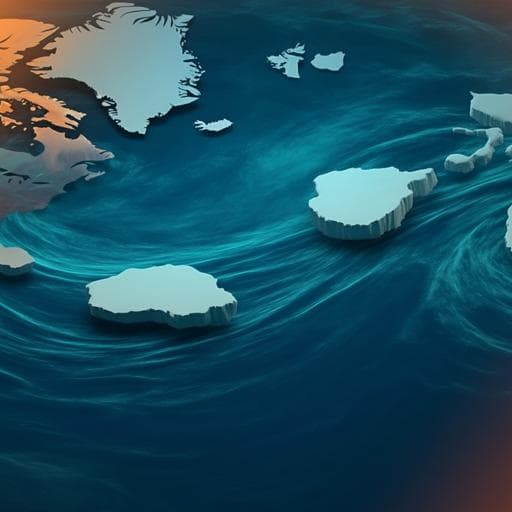
Earth Sciences
The IPWP as a capacitor for autumn sea ice loss in Northeastern Canada
L. Yu, S. Zhong, et al.
Discover how Indo-Pacific Warm Pool warming is driving Arctic sea ice loss in northeastern Canada, revealing a striking correlation where 45% of the observed sea ice reduction is attributable to this phenomenon. This groundbreaking research by Lejiang Yu, Shiyuan Zhong, Timo Vihma, Shuoyi Ding, Cuijuan Sui, and Bo Sun introduces the concept of the 'Arctic capacitor effect of the IPWP'.
~3 min • Beginner • English
Introduction
Arctic sea ice has undergone a significant decline over recent decades, especially since the late 1990s, largely attributed to surface warming from increased greenhouse gas concentrations. Observations show a robust, nearly linear relationship between cumulative CO2 emissions and September Arctic sea ice loss, suggesting a strong role for anthropogenic forcing amid complex Arctic feedbacks. In addition to local feedbacks, remote forcings can influence Arctic climate through large-scale atmospheric and oceanic circulation, transporting heat and moisture poleward. The Indo-Pacific Warm Pool (IPWP), defined as the region with sea surface temperatures exceeding 28 °C in the eastern Indian and western/central Pacific, has intensified and expanded in recent decades primarily due to greenhouse gas increases, with smaller contributions from internal modes such as the Pacific Decadal Oscillation. The IPWP affects monsoon systems, ENSO characteristics, and potentially the Arctic climate, yet the comprehensive impact of the entire IPWP on Arctic sea ice has remained uncertain. This study investigates whether greenhouse-gas-driven warming of the IPWP exerts a remote influence on Arctic sea ice, particularly during boreal autumn, and quantifies how much of the regional sea ice loss can be statistically linked to IPWP variability. The central hypothesis is that IPWP warming enhances tropical convection and drives planetary wave activity and stratosphere–troposphere coupling that modulate the Arctic Oscillation and circulation over the North Atlantic–Arctic sector, thereby reducing sea ice in northeastern Canada and adjacent seas.
Literature Review
Prior work has documented sustained declines in Arctic sea ice and highlighted both direct radiative forcing from greenhouse gases and indirect remote influences via large-scale circulation. A near-linear relation between cumulative CO2 emissions and September ice loss underscores the anthropogenic signal. Studies have examined how tropical SST anomalies, especially in the Pacific linked to ENSO, IPO/PDO, and the Indian Ocean, modulate Northern Hemisphere circulation and the AO/NAO, with repercussions for Arctic temperatures and sea ice. The IPWP has been shown to affect monsoons, ENSO characteristics, and tropical intraseasonal variability (e.g., the MJO), and its recent warming/expansion has been attributed mainly to anthropogenic forcing. While specific IPWP sub-regions or events (e.g., Indian Ocean warming, La Niña–like states) have been connected to Arctic variability, a holistic assessment of the broader IPWP’s role in Arctic sea ice loss has been lacking. Additionally, mechanisms involving Rossby wave sources, wave activity fluxes, and stratospheric pathways (EP flux and polar vortex modulation) have been proposed as links between tropical SSTs and high-latitude circulation, motivating the present study’s focus on the IPWP’s comprehensive impact.
Methodology
Study period and focus: The primary analyses focus on boreal autumn (October–December), when Arctic sea ice regrows rapidly from its September minimum, over recent decades when satellite-era observations are most reliable, supplemented by longer historical records for context.
Indices and regions: The IPWP index is defined as the area-averaged SST over 60°E–170°E, 15°S–15°N. The target Arctic region for sea ice analysis is a latitude–longitude box spanning 95°W–50°W and 50°N–80°N (Hudson Bay, Baffin Bay, Labrador Sea vicinity).
Observational and reanalysis datasets: Sea surface temperature: NOAA ERSSTv5. Sea ice concentration: NSIDC passive microwave (1979–present) and 20CRv3 for longer historical context (1836–2015). Atmospheric variables: ERA5 reanalysis (1940–present). Outgoing longwave radiation: NOAA Interpolated OLR (since 1974). Details of periods and resolutions are as provided in the paper’s Table 1.
Model simulations: Historical simulations from 49 CMIP6 models are used to assess the robustness of IPWP–Arctic sea ice relationships across models and periods (1850–2014, 1900–2014, 1970/1979–2014).
Statistical analyses: Linear correlations and regressions are performed between sea ice concentration and the (detrended) IPWP index. To focus on interannual to decadal covariability separate from common trends, the IPWP index is detrended and normalized before regression onto sea ice fields. Statistical significance is evaluated using two-tailed Student’s t-tests, accounting for effective degrees of freedom that adjust for lag-1 autocorrelation of the time series. Lead–lag analyses are conducted to examine the relationship between the autumn IPWP index and subsequent winter (JFM) sea ice concentration.
Attribution-style estimate: The IPWP-related contribution to the sea ice trend is estimated by multiplying the trend in the normalized IPWP index by the sea ice anomalies regressed onto the normalized, detrended IPWP index. The ratio of this IPWP-related trend to the observed trend within the target box provides an estimate of the fractional contribution of IPWP warming to regional sea ice loss.
Dynamical diagnostics: To investigate physical mechanisms, regressions onto the detrended IPWP index are computed for sea level pressure, surface winds, 2-m air temperature, downward longwave radiation, low-level specific humidity, vertical velocity, SST, OLR, Rossby wave source (RWS), 200-hPa divergent wind, 200-hPa geopotential height and wave activity flux, 100-hPa geopotential height, zonal wind, and Eliassen–Palm (EP) flux. These diagnostics assess tropospheric teleconnections, moisture and radiation feedbacks, and stratosphere–troposphere coupling including polar vortex changes.
Numerical experiments (CAM5): Using CAM5 (1.9°×2.5°, 30 vertical levels), a 50-year control run is forced by climatological SST and sea ice; the last 20 years serve as reference for idealized experiments. Two idealized experiments are conducted for October–December each year: (1) a +2 °C SST anomaly imposed over the IPWP subregion (80–160°E, 0–20°N); (2) prescribed SST anomaly patterns reflecting the IPWP-related SST regression map (Fig. 4a) north of 20°S. Differences between idealized and control runs diagnose the atmospheric response, including 200-hPa and 100-hPa geopotential heights, zonal wind, EP fluxes, and near-surface and lower-tropospheric temperatures.
Uncertainty and robustness: Observational results are compared with CMIP6 historical simulations; spatial pattern correlations between reanalysis-based regressions and model responses are computed (e.g., for 200-hPa height fields) to evaluate robustness. Significance is assessed at p<0.05 or p<0.01 depending on context, with stippling indicating regions above 90% confidence in maps.
Key Findings
- The IPWP has warmed significantly during boreal autumn over the last four decades, with an area-averaged SST trend of approximately 0.0146 °C per year (p<0.01).
- Arctic autumn sea ice concentration shows a significant inverse relationship with the IPWP index across the broader northeastern Canadian Arctic and sub-Arctic (Hudson Bay, Baffin Bay, Labrador Sea). Observational correlations in the box are −0.71 (p<0.05) before detrending and −0.40 (p<0.05) after detrending for 1979–2020; for 1900–2015 they are −0.49 (p<0.05) and −0.33 (p<0.05), respectively.
- CMIP6 historical simulations corroborate this relationship: 46/49, 45/49, and 37/49 models (94%, 92%, 75%) show significant negative correlations for 1850–2014, 1900–2014, and 1970–2014, respectively. Multi-model mean detrended correlation coefficients are −0.38 (1850–2014), −0.40 (1900–2014), and −0.44 (1979–2014), comparable to reanalysis-based results.
- Attribution-style estimate: Averaged over the target box, about 45% of the observed autumn sea ice loss is statistically linked to IPWP warming (ratio of IPWP-related trend to total trend ≈45%). Other Arctic regions exhibit smaller or even opposite-sign contributions (e.g., near the Denmark Strait and parts of the Barents Sea).
- Lead–lag behavior: The autumn IPWP index is inversely correlated with subsequent winter (JFM) sea ice in the North Atlantic on both sides of 30°W and shows a dipole in the North Pacific, suggesting an autumn-to-winter influence.
- Dynamical mechanism: Warmer IPWP corresponds to a negative AO state (IPWP–AO correlation ≈ −0.36, p<0.05), and the AO index positively correlates with sea ice anomalies in the target region (≈0.39, p<0.05). A Greenland-centered anticyclonic anomaly advects warm, moist air into the region, increasing surface air temperature and downward longwave radiation via enhanced atmospheric moisture, with adiabatic warming playing a lesser role. Onshore wind stress further reduces ice concentration.
- Teleconnections: IPWP warming strengthens the tropical Pacific SST gradient and tropical convection (negative OLR anomalies), generating negative Rossby wave sources and 200-hPa divergent wind anomalies that excite a planetary wavetrain. The wavetrain propagates into the North Pacific and toward the Arctic and Greenland, producing negative midlatitude and positive Arctic 200-hPa geopotential height anomalies consistent with a negative AO. A stratospheric pathway is also evident: weakened polar vortex (altered zonal winds and EP flux divergence/convergence), which projects onto negative AO in the troposphere. Transient eddy momentum flux convergence contributes to decreased 200-hPa zonal wind at 50–80°N, complementing Rossby wave effects.
- Numerical experiments: CAM5 idealized runs with +2 °C IPWP SST anomalies reproduce key features of the wavetrain and high-latitude height responses; spatial correlation with reanalysis-based 200-hPa height regression is 0.32 (p<0.01). Experiments prescribing broader IPWP-related SST anomaly patterns yield a higher spatial correlation of 0.61 (p<0.01) and also indicate a weakened polar vortex and positive 850-hPa temperature anomalies over high-latitude North America and the Arctic.
- Conceptual advance: The study proposes the “Arctic capacitor effect of the IPWP,” wherein greenhouse-gas-driven IPWP warming stores and releases energy to enhance tropical convection, excite teleconnections, weaken the polar vortex, induce negative AO, and ultimately reduce autumn sea ice in northeastern Canada and adjacent seas.
Discussion
The findings support the hypothesis that tropical Indo-Pacific warming can remotely modulate Arctic climate and contribute substantially to regional autumn sea ice loss. The strong, statistically significant inverse relationships across multiple periods and datasets, together with physical consistency in atmospheric circulation, moisture, radiation, and wave activity diagnostics, and supportive idealized model experiments, provide a coherent picture linking IPWP variability to the Arctic. The identified mechanism hinges on enhanced tropical convection and a planetary wavetrain that projects onto a negative AO and a weakened polar vortex, enabling warm and moist advection and enhanced downward longwave radiation into the Hudson Bay–Baffin Bay–Labrador Sea sector. This framework elucidates an indirect pathway by which greenhouse gas increases, via the IPWP, affect Arctic sea ice, thereby extending understanding beyond local Arctic feedbacks. While the analysis emphasizes northeastern Canada and adjacent seas, it also notes heterogeneous responses elsewhere in the Arctic and highlights the importance of considering regional variability and competing influences from internal modes (PDO/AMO) and other tropical basins. The conceptualization of the IPWP as a “capacitor” underscores the role of tropical oceans in storing and releasing energy that affects high-latitude climate, with implications for prediction and attribution in a warming world.
Conclusion
This study documents a robust inverse relationship between boreal autumn IPWP variability and autumn Arctic sea ice concentration in northeastern Canada and adjacent seas and estimates that about 45% of the regional sea ice decline is statistically linked to IPWP warming. Through observational analyses, CMIP6 model corroboration, atmospheric diagnostics, and idealized CAM5 experiments, the work proposes the “Arctic capacitor effect of the IPWP,” whereby greenhouse-gas-driven tropical warming enhances convection, drives a planetary wavetrain, weakens the polar vortex, induces a negative AO, and promotes warm/moist advection and radiative feedbacks that reduce sea ice. These results highlight the crucial role of tropical oceans in shaping Arctic climate and emphasize the need to incorporate tropical teleconnections into Arctic sea ice prediction and projection efforts. Future research should test the robustness of these conclusions using fully coupled pacemaker experiments, explore the interplay with internal climate variability (PDO/AMO), assess regional heterogeneity across the Arctic, and evaluate whether other ocean basins exhibit analogous capacitor-like effects.
Limitations
- Attribution is primarily statistical, relying on regressions and correlations; while mechanisms are physically plausible and supported by idealized model experiments, fully coupled pacemaker experiments are needed for stronger causal inference.
- Some differences exist between reanalysis-based regression patterns and idealized model responses in the location and amplitude of anomalies.
- The estimated 45% contribution is region-specific (Hudson Bay–Baffin Bay–Labrador Sea) and season-specific (boreal autumn); results should not be generalized to the entire Arctic or other seasons without further analysis.
- Internal climate variability (e.g., PDO, AMO) and other remote forcings also influence Arctic sea ice and may confound simple linear relationships.
- Observational uncertainties are larger prior to the satellite era; thus, analyses emphasizing recent decades are more reliable than early 20th-century estimates.
Related Publications
Explore these studies to deepen your understanding of the subject.







